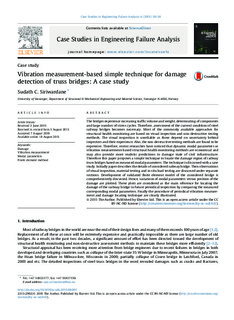| dc.contributor.author | Siriwardane, S.A.Sudath C. | |
| dc.date.accessioned | 2016-01-07T12:54:09Z | |
| dc.date.available | 2016-01-07T12:54:09Z | |
| dc.date.issued | 2015-08 | |
| dc.identifier.citation | Siriwardane, S. (2015) Vibration measurement-based simple technique for damage detection of truss bridges: A case study. Case Studies in Engineering Failure Analysis, 4, pp. 50-58 | nb_NO |
| dc.identifier.uri | http://hdl.handle.net/11250/2372842 | |
| dc.description | (C) 2015 The Author. Published by Elsevier Ltd in Case Studies in Engineering Failure Analysis, vol. 4. This is an open access article under the CC
BY-NC-ND license (http://creativecommons.org/licenses/by-nc-nd/4.0/). | nb_NO |
| dc.description.abstract | The bridges experience increasing traffic volume and weight, deteriorating of components
and large number of stress cycles. Therefore, assessment of the current condition of steel
railway bridges becomes necessary. Most of the commonly available approaches for
structural health monitoring are based on visual inspection and non-destructive testing
methods. The visual inspection is unreliable as those depend on uncertainty behind
inspectors and their experience. Also, the non-destructive testing methods are found to be
expensive. Therefore, recent researches have noticed that dynamic modal parameters or
vibration measurement-based structural health monitoring methods are economical and
may also provide more realistic predictions to damage state of civil infrastructure.
Therefore this paper proposes a simple technique to locate the damage region of railway
truss bridges based on measured modal parameters. The technique is discussed with a case
study. Initially paper describes the details of considered railway bridge. Then observations
of visual inspection, material testing and in situ load testing are discussed under separate
sections. Development of validated finite element model of the considered bridge is
comprehensively discussed. Hence, variations of modal parameters versus position of the
damage are plotted. These plots are considered as the main reference for locating the
damage of the railway bridge in future periodical inspection by comparing the measured
corresponding modal parameters. Finally the procedure of periodical vibration measure-
ment and damage locating technique are clearly illustrated. | nb_NO |
| dc.language.iso | eng | nb_NO |
| dc.publisher | Elsevier | nb_NO |
| dc.rights | Navngivelse-Ikkekommersiell-IngenBearbeidelse 3.0 Norge | * |
| dc.rights.uri | http://creativecommons.org/licenses/by-nc-nd/3.0/no/ | * |
| dc.subject | damage | nb_NO |
| dc.subject | vibration measurement | nb_NO |
| dc.subject | modal parameters | nb_NO |
| dc.subject | finite element method | nb_NO |
| dc.subject | vibrasjoner | nb_NO |
| dc.subject | bru | nb_NO |
| dc.title | Vibration measurement-based simple technique for damage detection of truss bridges: A case study. | nb_NO |
| dc.type | Journal article | nb_NO |
| dc.type | Peer reviewed | nb_NO |
| dc.subject.nsi | VDP::Technology: 500::Mechanical engineering: 570 | nb_NO |
| dc.source.pagenumber | 50-58 | nb_NO |
| dc.source.volume | 4 | nb_NO |
| dc.source.journal | Case Studies in Engineering Failure Analysis | nb_NO |
| dc.identifier.doi | 10.1016/j.csefa.2015.08.001 | |

